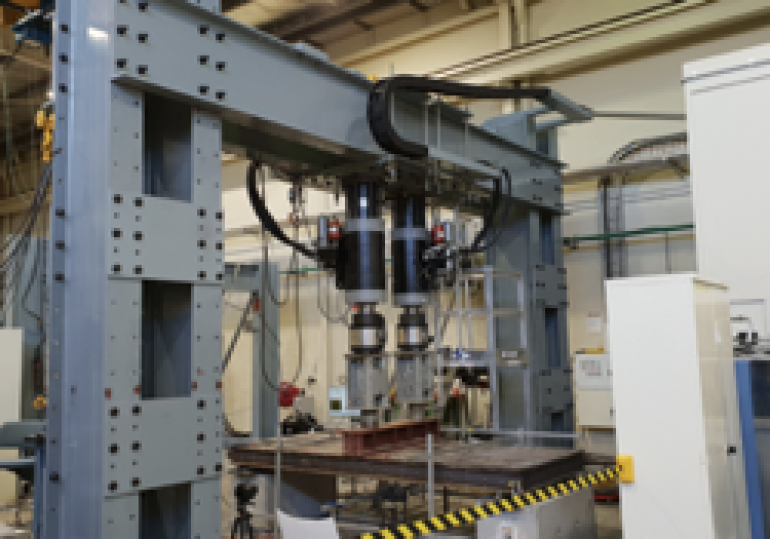Capabilities
Industrial Ecology Virtual Laboratory (IELab, https://ielab.info) and Embodied Carbon Explorer (ECE Tool, https://ece.ielab-aus.info).
Description: The Embodied Carbon Explorer (ECE) Tool was created by the Sustainable Assessment Program at UNSW Sydney, supported by the CRC for Low Carbon Living and is based on the Australian Industrial Ecology Virtual Laboratory (IELab). It enables the rapid evaluation of Scope 3 carbon emissions in a wide range of products and services (e.g., precinct, building, organisation, etc.). It is well suited for a quick screening assessment before full, detailed assessments are undertaken. (Embodied Carbon Explorer (ECE Tool, https://ece.ielab-aus.info)

Thermal conductivity measurement by Trident (C-Therm)
Description: Trident measures thermal conductivity and effusivity of materials with applications in textiles, polymers, batteries, automotive vehicles, phase change materials, additive manufacturing, insulation, heat transfer fluids, oil & gas, explosives, building materials, Thermal interface materials, geological, metals, nanomaterials.
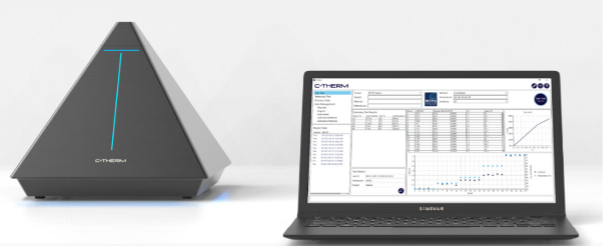
Automated Construction Engineering
Led by Dr Johnson Shen, the Autonomy and Intelligence in Construction laboratory (AICON) has research interests in Autonomous Systems, Construction automation and robotics, Artificial Intelligence, Digital Twins, Smart Sensing, Internet of Things, Mixed Reality, and their applications in the preparation, construction, operation, and maintenance of civil infrastructure and the built environment.
Competitive advantage
Long history of working successfully with industry partners
Impact
We can support SME and large corporate businesses to develop innovative technologies
Successful applications
AICON research projects have included:
- Real-Time 3D Light Detection and Ranging (LiDAR) Mapping with Unmanned Aerial Vehicles (UAV) or Drones AI-enabled Automated As-built Building Information Modelling (BIM)
- Field Emissions and Fuel Consumption Modelling of Construction Equipment
- Automated Machine Control and Guidance in Construction
- Tunnel Boring Machine Tunnelling Methods and Trenchless Techniques for Urban Underground Infrastructure Construction
Capabilities and facilities
Dr Shen represents Australia on the Board of Directors of the prestigious International Association for Automation and Robotics in Construction (IAARC).
Our partners
Linke & Linke Surveys
Projectvision
Smart Welding Solutions t/a Cortex Business

Construction Automation Laboratory
Centre for Infrastructure, Engineering & Safety (CIES) is internationally renowned for excellence in experimental, theoretical and applied research. Our aim is to make infrastructure safer, more reliable, sustainable, and cost effective. Our Construction Automation Laboratory led by Churchill Fellow Dr Ali Kashani will be used to fundamentally research, develop, refine, and systematically evaluate automated construction techniques for increased collaboration with industry.
Competitive advantage
Long history of working successfully with industry partners, leading to rapid technology transfer
Award-winning researchers recognised globally as leaders in their field State-of-art facilities for prototyping and testing with strong knowledge base
Impact
The Australian construction industry is lagging behind in adoption of digital construction compared to the developed countries, but this situation can be changed through R&D, collaborative projects, and partnership between research institutes and industries
CIES intends to play an important role in construction automation not only in Australia but also internationally by fulfilling the need for a research facility to implement collaborative robots for construction This research facility will be used for construction automation process including 3D printing, modular automated construction and structural assembly, shotcreting, and automated bricklaying
The research projects aim for increased construction productivity, sustainable and low-carbon construction, disaster-relief and affordable accommodation
Capabilities and facilities
The state-of-the-art research facility will enable new methods of digital 3D printing by addressing the reinforcement issue and other main challenges of construction 3D printing. Equipment includes:
Two ABB IRB6700 robots with payload of 200 kg and reach of 2.6 m
Four vaccum cups and three 2-finger grippers for picking and placing of a range of objects from rheo stater bars to timber frames and studs, bricks, and aerated concrete blocks
Concrete mixer-pump for mixing dry powders with water and delivery of up to 10 m
Special-designed nozzle for 3D printing of both one-part and multiple-parts mortars
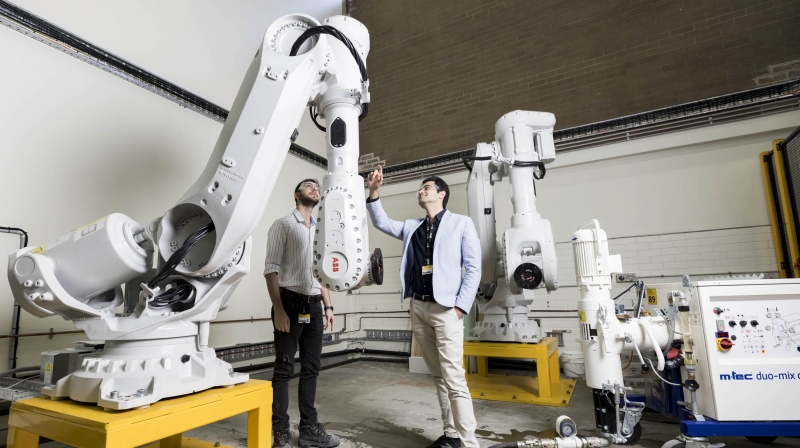
Construction Materials Testing
CIES laboratories are well equipped to conduct any type of experiments and tests, including mechanical and durability tests, and characterisation of materials – on a wide range of construction materials, such as concrete, asphalt, steel, timber and any components - including aggregates, supplementary cementitious materials, emulsion, industrial by-wastes, etc.
Competitive advantage
We have the depth of knowledge, expertise and resources to take on projects from the nano- to macro-scale
State of the art equipment and facilities, and 70 years of experience
Impact
The Centre has played a large role in the development of a number of major Australian construction standards. The Centre has investigated feasible applications to turn various waste materials to construction materials for Circular Economy and Waste recycling. We are world experts in concrete, steel, timber and composite structures.
Successful applications
- World-first green concrete trial with City of Sydney using low-CO2 geopolymer concrete on a busy city road
- Developed concrete mix design approach to reduce early-age cracking of concrete
- Developed concrete mix designs to maximize the usage of glass waste
- Undertaken long-term sustained load tests on a wide variety of reinforced and prestressed concrete structures
- Our experimental research has led to design methodologies that have been incorporated directly into the Australian Standard for Concrete Structures, AS3600
Capabilities and facilities
Our Heavy Structures Laboratories are equipped with state-of-the-art servo-controlled hydraulic actuators and universal testing machines to maintain a capacity for high load testing, ranging from 10 kN to 5000 kN
Cementitious Materials Laboratory is equipped with cutting-edge facilities for measuring cement and concrete materials characterisation and for durability testing
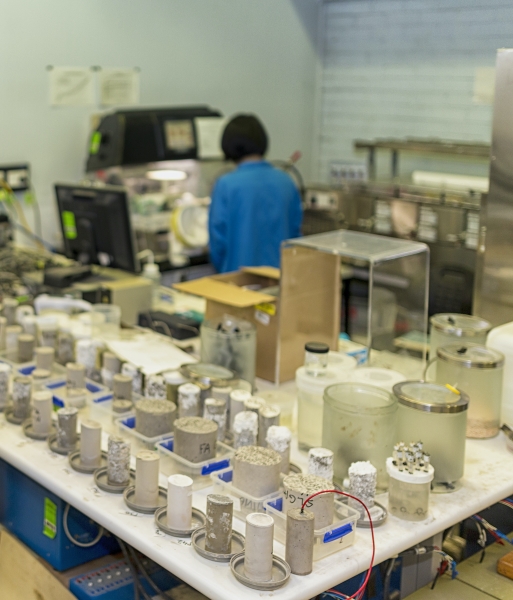
Digital twins for mapping and modelling carbon emissions
Access to and use of consistent geospatial data on the sources of carbon emissions, such as buildings, industrial plants, and farming, is a significant challenge for decarbonisation efforts. We undertake research on the standardisation of 3D mapping and modelling, digital twins, to facilitate a common approach to understanding and managing carbon emissions in various industries and processes. By creating standardised virtual replicas of physical assets, systems, or entire industrial operations, using digital twins, we facilitate real-time data integration, analytics, and modelling capabilities to simulate and visualise carbon emissions in a highly detailed manner. 3D digital representations help monitor and track emissions at a granular level, allowing for accurate identification of emission sources, estimation of emission rates, and assessment of their geographical distribution. We also undertake research on making geospatial standards interoperable with other standards, such as IoT.

Geotechnical Engineering
Our geotechnical engineering research spans across fundamental and applied soil mechanics, modelling of soil behaviour, rock mechanics and dam engineering. Our well-equipped laboratories contain a diverse range of soil, rock and asphalt testing equipment, along with specialist and advanced equipment used to support industry- focused research. Our researchers are award-winning and recognised globally as leaders in their field.
Competitive advantage
The scale of our laboratory capability is not available in any other university in Australia
Long history of working successfully with industry partners
Impact
We are internationally renowned for our excellence in experimental, theoretical and applied soil, rock and asphalt research. Our aim is to make infrastructure safer, more reliable, and cost effective.
Successful applications
The geotechnical engineering research group at CIES has received several million dollars in competitive grants, including ARC and industry funded grants. Areas of current research include:
- Cost-effective design of cut batters, soil nailing, retaining structures and foundations in low strength rocks encountered in the Upper Blue Mountain region of NSW
- Rehabilitation of Cadia Tailings Storage Facility, Orange, NSW
- Monitoring and integrity assessment of railway embankments, Wollongong, NSW
- Warragamba Dam raising
- Understanding earthquake-induced ground deformation risk to inform city resilience
Capabilities and facilities
Multiples of the most highly used equipment enable an ambitious program of industry and research experiments - completed in a timely manner.
Research facilities include:
Calibration chamber for conducting cone penetration tests in unsaturated soils
Equipment to test unsaturated soils, erosion of soils, instability and failure in soil and rock samples, for testing gravel, rock and sands undergoing particle crushing
State-of-the-art soil and rock testing facilities including an Asphalt testing laboratory
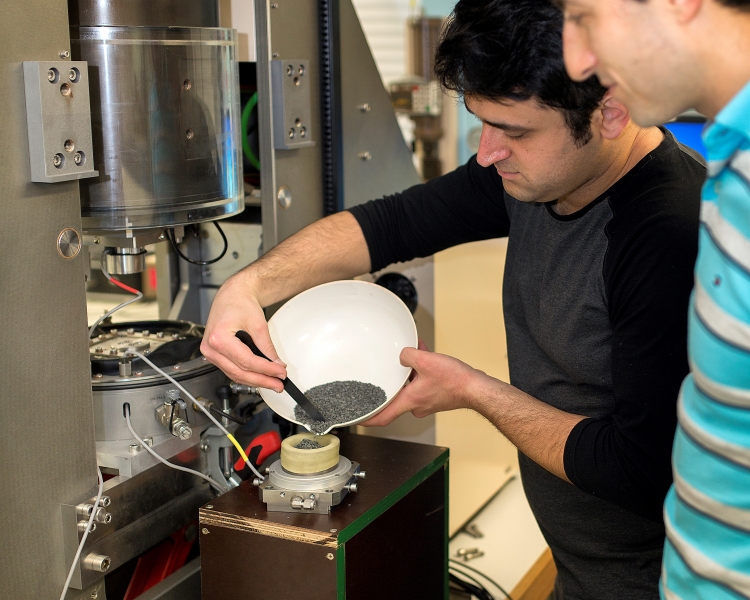
Structural Engineering
The CIES structural engineering research group investigate the structural integrity of materials used in buildings, bridges, dams, tunnels and roads when exposed to natural phenomena or hostile environments. Our focus is on resilient, sustainable, and energy-efficient infrastructure. We contribute to Australian and International standards and codes of practice for concrete, steel, composite and bridge structures.
Competitive advantage
- We have the depth of knowledge, expertise and resources to take on projects from the nanoscale to macro scales
- Largest structural testing facilities in Southern hemisphere
- State of the art equipment and computational facilities
- Research experts in: Cement chemistry and cementitious materials, Concrete, steel and timber structures & materials, including hybrid (composite) construction technologies and the use of FRP composite materials in construction, Geopolymer concrete, Advanced computational structural analysis
Impact
We have the people and resources to service and solve our industry problems and challenges, including product development opportunities.
Successful applications
- World-first green concrete trial with City of Sydney – using geopolymer low-CO2 concrete on busy city road
- Developed a new high-density (low carbon) geopolymer concrete that greatly enhanced the stability of armour units on breakwaters – Port Kembla trial
- Developed a mix design approach to reduce early-age thermal cracking of concrete
- Have demonstrated the feasibility and superior structural performance of innovative steel-timber systems compared to conventional steel- concrete composite
- Award winning for structural health monitoring of bridges
- Delivered knowledge on the performance of energy-efficient insulating concrete sandwich panels that was accepted by international standard committees
Capabilities and facilities
Our Heavy Structures Laboratories are equipped with state-of-the-art servo-controlled hydraulic actuators and universal testing
machines to maintain a capacity for high load testing, ranging from 10 kN to 5000 kN, including the ability to apply cyclic fatigue loading, horizontal loading, and long-term creep testing
Cementitious Materials Laboratory – is equipped with cutting-edge facilities for measuring cement and concrete materials characterisation and for durability testing
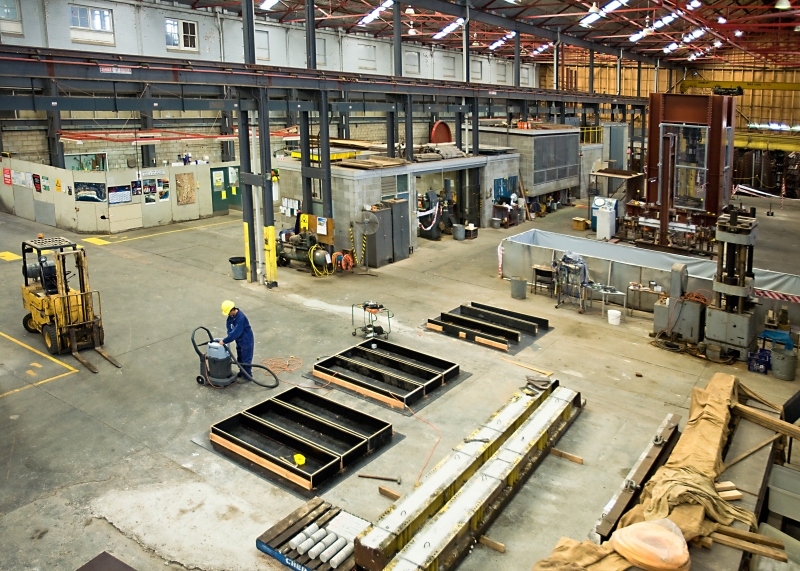
Structural Testing Laboratory (UNSW Canberra)
The Structural Testing Laboratory (soils, concrete and steel) houses a wide variety of testing facilities.
The main test rig at is capable of testing concrete panels and beams of sized up to 3.5m x 4.0m where a maximum load of 1000 kN can be applied. The test rig is highly configurable with two 500kN actuators, one 250kN actuator and one 100kN actuator. All actuators are connected to fully an automatic and programable hydraulic control system. They can be employed to conduct a wide range of quasi-static, and dynamic and fatigue tests with a large range of loads and displacement limits.
The laboratory is also equipped with three dynamic material testing machines with capacity ranging from 5kN to 250kN, two standard concrete compression machines with capacities of 3000kN and 5000kN and other standard concrete specimen testing equipment including a 4 point bending test machine.
These facilities are used for undergraduate classes and thesis work, and postgraduate and academic research.
